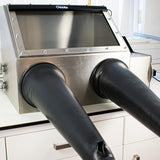Glove Box Pressure: Positive or Negative?
Glove boxes are essential tools for creating controlled atmospheres where you can handle hazardous or air sensitive materials. They can be maintained at positive pressure or negative pressure. Both create atmospheres separate from ambient, keeping a barrier between your materials and the external lab environment. There are some situations where either a positive or negative pressure glove box will be more suitable for your experiment.

Positive Pressure Glove Box
In most cases, glove boxes are kept at a positive pressure difference, also known as overpressure. You only need the internal chamber environment to be a few mbar overpressure to create a positive pressure glove box. At overpressure, the gloves will stand erect from the box. If there are any leaks in the glove box, the internal gases are pushed outwards into the atmosphere, protecting the inert internal environment. This slows down the diffusion of contaminants, like air and moisture, into the glove box.
Positive pressure glove boxes are ideal for handling air-sensitive materials which pose little harm to the user, or if you are using hazardous materials in small quantities. Many researchers use overpressure glove boxes to store materials that degrade in air, such as hygroscopic compounds. They are often called isolation glove boxes, as they isolate sensitive materials from contaminants.
Negative Pressure Glove Box
On the other hand, negative pressure glove boxes are the better choice if you are working with dangerous materials, such as nuclear material. The internal chamber is held slightly under atmospheric pressure. In the event of a leak, air from outside the glove box is drawn in, compromising the internal environment but preventing any hazardous material from escaping. These systems often incorporate additional protective measures to further ensure the safety of lab users.
Negative pressure glove boxes are used to handle dangerous samples where extra precautions are needed to ensure users safety. For this reason, they are sometimes referred to as containment glove boxes.
Glove Box Pressure Control
Every glove box system varies in its pressure requirements and control mechanisms. The Ossila Glove Box uses a pressure feedback system with oxygen and moisture detectors to monitor and maintain conditions within its internal chambers.
When the automated purging system is active, the glove box allows inert gas into the system while letting internal gas out, ensuring the desired conditions are consistently sustained. Should the pressure drop too low, inert gas is introduced to the glove box through a gas line. An outlet valve opens to release excess gas if the pressure becomes too high. Our glove box is designed to withstand an overpressure of between 0 and 5 mbar above atmospheric pressure, and it is equipped with a pressure relief valve to limit excess pressure build-up.
Pressure control is an important factor when conducting leak tests. In a leak test, the internal chamber pressure is raised or lowered to a level significantly above or below atmospheric pressure. The glove box chamber is sealed and the pressure levels within this closed system are tracked. Performing a leak test should tell you how well sealed your glove box is and highlight if there are any significant compromises in your system. If the pressure levels within the chamber change dramatically over the course of a leak test, you may have a leak.

Most leak tests are performed at overpressure, as this makes it easier to identify leaks while keeping the internal system intact. However, negative pressure leak tests may be more thorough in revealing potential leaks. Holding a glove box at negative pressure can highlight more compromises in the system. Conducting leak tests helps determine the integrity of the seals and identifies any significant flaws that may affect the performance.
Our glove box is designed to quickly and easily create a positive pressure inert environment, enabling you to conduct air-sensitive experiments safely.
Glove Box

- Benchtop
- High Performance
- Inert Environment
Buy Online £8,500

